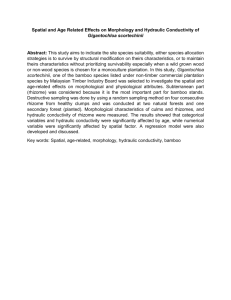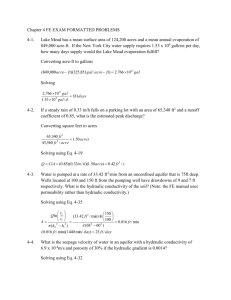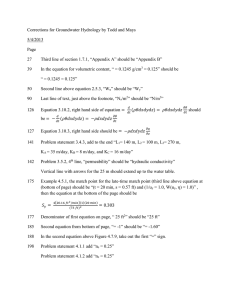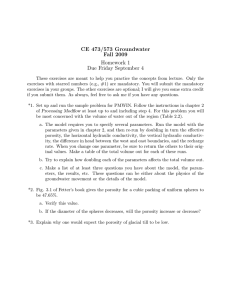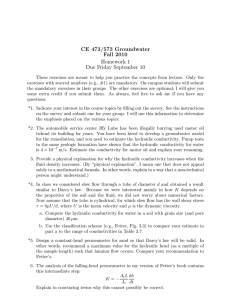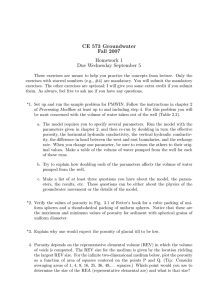Document 13730990
advertisement
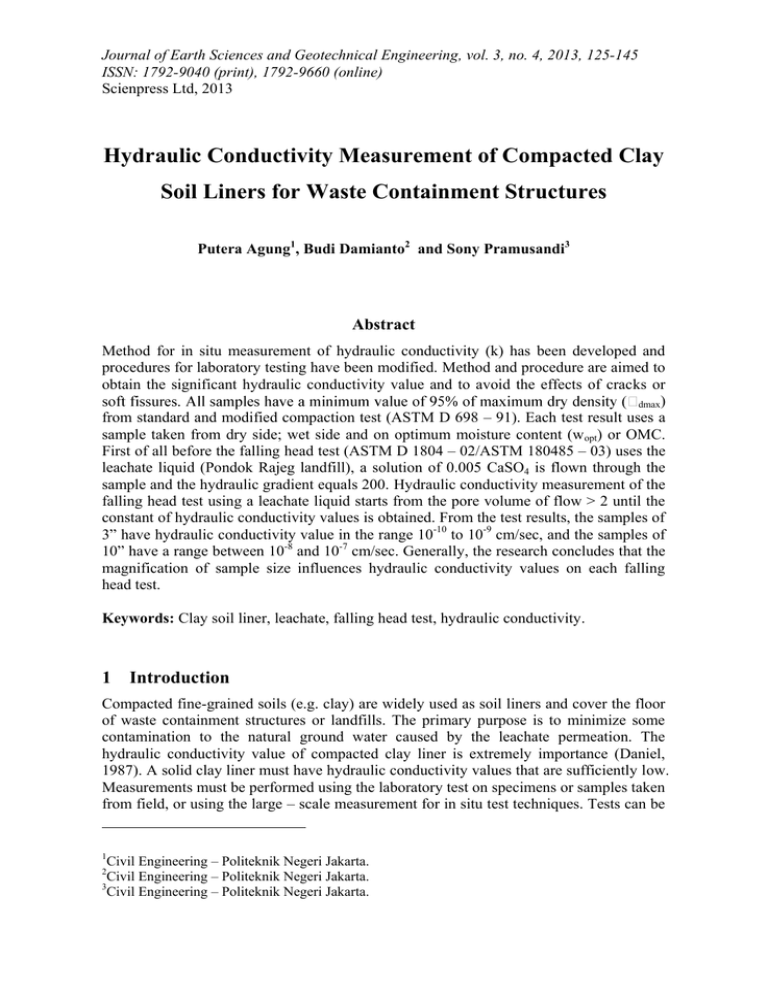
Journal of Earth Sciences and Geotechnical Engineering, vol. 3, no. 4, 2013, 125-145 ISSN: 1792-9040 (print), 1792-9660 (online) Scienpress Ltd, 2013 Hydraulic Conductivity Measurement of Compacted Clay Soil Liners for Waste Containment Structures Putera Agung1, Budi Damianto2 and Sony Pramusandi3 Abstract Method for in situ measurement of hydraulic conductivity (k) has been developed and procedures for laboratory testing have been modified. Method and procedure are aimed to obtain the significant hydraulic conductivity value and to avoid the effects of cracks or dmax) from standard and modified compaction test (ASTM D 698 – 91). Each test result uses a sample taken from dry side; wet side and on optimum moisture content (w opt) or OMC. First of all before the falling head test (ASTM D 1804 – 02/ASTM 180485 – 03) uses the leachate liquid (Pondok Rajeg landfill), a solution of 0.005 CaSO4 is flown through the sample and the hydraulic gradient equals 200. Hydraulic conductivity measurement of the falling head test using a leachate liquid starts from the pore volume of flow > 2 until the constant of hydraulic conductivity values is obtained. From the test results, the samples of 3” have hydraulic conductivity value in the range 10-10 to 10-9 cm/sec, and the samples of 10” have a range between 10-8 and 10-7 cm/sec. Generally, the research concludes that the magnification of sample size influences hydraulic conductivity values on each falling head test. Keywords: Clay soil liner, leachate, falling head test, hydraulic conductivity. 1 Introduction Compacted fine-grained soils (e.g. clay) are widely used as soil liners and cover the floor of waste containment structures or landfills. The primary purpose is to minimize some contamination to the natural ground water caused by the leachate permeation. The hydraulic conductivity value of compacted clay liner is extremely importance (Daniel, 1987). A solid clay liner must have hydraulic conductivity values that are sufficiently low. Measurements must be performed using the laboratory test on specimens or samples taken from field, or using the large – scale measurement for in situ test techniques. Tests can be Civil Engineering – Politeknik Negeri Jakarta. Civil Engineering – Politeknik Negeri Jakarta. 3 Civil Engineering – Politeknik Negeri Jakarta. 1 2 126 Putera Agung, Budi Damianto and Sony Pramusandi conducted on the previous construction or prior to construction. Several studies from literature shows that the hydraulic conductivity values of compacted soil are influenced significantly by volume or dimension of block samples (Daniel, 1984; Day and Daniel, 1985; Elsbury et al, 1988). From these studies, the measurements on small samples produces the hydraulic conductivity values lower than the measurements obtained from big samples. The measurement results on small sample also indicate the values lower than the values of the large – scale of in situ test results. It can be concluded that the measurements on small – samples cannot represent the existing field condition. The article presents a logical alternative to conduct the measurement hydraulic conductivity using the standard laboratory tests on the big enough of samples size to simulate the existing field conditions. Laboratory tests can be performed rapidly and the data results obtained more accurate. Furthermore, methods to perform standard laboratory tests can be developed from the standard to ensure consistency of laboratory data results through the Falling Head Test (ASTM D 1804-02/ASTM 180485-03). This research has modified the Falling Head Test to measure the hydraulic conductivity from clay liner samples. The research study has selected 2 (two) sizes or dimensions of the clay liner samples, where they can be compared each other in the later. The study uses a sample of clay liner diameter of 3” with the thickness of 1.0 cm and a diameter 10” with the thickness 8.0 cm. 2 Background 2.1 Discrepancies Data Results of Hydraulic Conductivity Test Daniel (1984) conducted and compared data results of hydraulic conductivity values in laboratory using the different volume or dimension samples. Daniel (1984) found that hydraulic conductivity values from big sample were generally reaching 10 to 1000 times larger than small sample. Based on these results, Daniel (1984) concluded that main problem relating with laboratory hydraulic conductivity tests on small samples is inability to detect distribution of cracks; soft fissures at the time of test. Day and Daniel (1985) concluded that hydraulic conductivity values from the big samples were controlled by macro pores that were located between porous stone or sand and clay samples. Elsbury et al (1988) also showed that the hydraulic conductivity from the larger samples could reach values 4 to 5 times than hydraulic conductivity values measured in small samples. 2.2 Similarities Data Results of Hydraulic Conductivity Test Several investigators (Lahti et al (1987); Reades et al (1990); Gordon et al (1989); Johnson et al (1990)) also observed the relationship between small and big sample on the hydraulic conductivity at laboratory works. They found that generally, the previous research results produce a wide variation of relationship between small and big samples used on the laboratory testing. 2.3 Current Laboratory Works for Hydraulic Conductivity Test The objective of current research study is also to control the quality Falling Head test Hydraulic Conductivity of Compacted Clay Soil Liners 127 (ASTM D 1804 – 02/ASTM 180485 – 03) to measure the hydraulic conductivity from laboratory tests. All samples are compacted using devices or tools of standard or modified compaction test. 3 Testing Procedures Experiments are conducted on samples with diameter 3” and thickness 1.0 cm; and diameter 10” and thickness 8.0 cm, respectively. All test samples are conducted in the laboratory using a constituted flexible – wall permeameter as shown as in Fig. 1. 3.1 Laboratory Test The soil properties of samples are evaluated by general standard testing for fine grained dmax) and optimum moisture content (OMC) or (wopt) was determined by standard compaction test and both the data results were compared to the data result from the modified compaction test; hydraulic conductivity (k) value measured by a constituted flexible – wall permeameter. Generally, flow chart of testing procedure performed at soil mechanic and foundation laboratory of Civil Engineering of Politeknik Negeri Jakarta (PNJ) or State Polytechnic Jakarta is shown on Figure 2 Diameter of clay samples as soil liners used in this study is 3” (inches) and 10” (inches). Study uses standard solution of 0.005 N CaSO4 during saturation process. 128 Putera Agung, Budi Damianto and Sony Pramusandi Figure 1: A constituted flexible – wall permeameter Hydraulic Conductivity of Compacted Clay Soil Liners Figure 2: Flow chart research study 129 130 No. 1. 2. 3. 4. 5. 6. Putera Agung, Budi Damianto and Sony Pramusandi Table 1: General soil properties of Beji clay Soil properties Natural water content (w) (%) Bulk density ( m) (gr/cm3) Specific gravity (Gs) Atterberg limits: a. Liquid limit (LL), (%) b. Plastic limit (PL), (%) c. Plasticity index (PI), (%) d. Shrinkage limit (SL), (%) Sieve analysis (weight of 500 gr) passed on sieve No. 200 (gr) Hydrometer analysis (% diameter < 0.002 mm) (%) Result 45.7 1.6 2.68 90.0 44.8 45.2 24.9 491,1 80 – 90 (clay) The saturation process is stopped when the pore volume of flow larger than or equals 2.0, and then the solution of 0.005 N CaSO4 is substituted by leachate. Clay soils used in this study are taken from around Kecamatan Beji, Kota Depok and leachate sample was taken from waste disposal area (WDA) Pondok Rajeg, Cilodong, Sukmajaya. Soil properties results are shown in Table 1 and the chemical contents of leachate from Depok landfill (WDA) are shown in Table 2. The chemical contents of Depok clay are shown in Table 3 where all samples were tested at Laboratory of Chemical Department, University of Indonesia (UI), Depok Campus. Based on the Table 3, it can be predicted that all clays mineral are very tiny crystalline substances evolved primarily from chemical weathering of certain rock-forming minerals (Holtz and Kovac, 1981). Chemically, they are hydrous aluminosilicates plus other metallic ions. From chemical composition, the soil has kaolinite or illite minerals in a large fraction; while montmorillonite exists in a small fraction. Based on Table 1, mean natural water content of soil samples is 45.7 %, where according to Bowles (1977) the water content is less than 60 % for dry surface condition. Specific gravity (Gs) is 2.68, based on NAFAC (1971) the specific gravity of clay is between 2.5 to 2.9. Soil has mean grain size less than 0.002 mm and it can be classified as MH & OH based on Unified Soil Classification System (USCS). From Table 2, it can be known that the leachate has the high concentration of BOD and COD. In addition to the leachate has a high value of fatty acid; pH; smell; the leachate also has an ammonia, N organic, Zn, Mg, Cl, Pb and small number of the other of heavy metal. Based on geotechnical and geology map for Kota Depok, soil layers at Beji location is red latosol with fine texture and came from uncemented of andesite tuff (initial of soil layer is 28) (Figure 3). Hydraulic Conductivity of Compacted Clay Soil Liners 131 Table 2: Chemical contents of leachate Chemical elements unit Alkalinity PP MD pH CO2 Cl Water hardness Total of CaCO3 Ammonia (NH4-N) Nitrate (N03-N) 10.0 22.2 8.2 0.0 15.0 13.2 22.2 51.6 2.3 Nitrite (NO2-NO) Phosphate (PO4) Sulphate (SO4) DO / DIS Oxygen (O2) 0.5 0.9 44.5 4.8 COD / dichromate 1,326.0 BOD 785.0 Detergent 3.9 Phenol - Magnesium (Mg) 7.0 Plumbum (Pb) 0.4 Zinc (Source : Dinas Kebersihan dan Pertamanan tahun 1996, Pemda Kotatip Depok) Note: unit (mg/l), excepted for pH 3.2 Data Results Analysis Mean of water line reading (0.005N CaSO4 solution and leachate) at the cylinder of gauge – glass (or burette) on falling head test (ASTM) were observed and recorded, then the hydraulic conductivity (k) values are determined by the equation: k 2.303 h a .L log 1 A.t h2 (1) All measurements of hydraulic conductivity (k) are plotted on graphic relationship between hydraulic conductivity (k) vs. time (day) for reading. 132 No. Putera Agung, Budi Damianto and Sony Pramusandi Table 3: Chemical content of Depok clay (Laboratory of chemical department – University of Indonesia) Chemical Result Unit Method element 1 Magnesium (Mg2+) 2 Sodium (Na+) 3 Potassium (K+) 4 Calcium (Ca++) 5 Chloride (Cl-) 6 Sulphate (SO42-) 7 Silicate (SiO2) 8 pH Note: ppm = part per million 194.0 70.5 245.3 14.2 37.9 261.3 49.0 7.6 ppm ppm ppm ppm ppm ppm % - AAS AAS AAS AAS Ion-meter Spectrometer Gravimetric pH meter Figure 3: Identification of soil sample based on the geotechnical and geology map of Kotatip Depok, West Java (2005) 4 Results and Discussion 4.1 Characteristic of Compacted Clay Data results of standard compaction test are shown in Figure 3. Hydraulic conductivity (k) are evaluated with using 3 (three) zones of water content, such as: dry side; optimum point; and wet side as shown as in Figures 4a and 4b based on relationship between water content and particle orientation in standard compaction test as well as the suggestion from Lambe (1958). Hydraulic Conductivity of Compacted Clay Soil Liners 133 4.2 Hydraulic Conductivity Values The relationships between hydraulic conductivity of Beji clay liner and time are shown in Figure 5 (diameter of sample 3” and thickness 1.0 cm) and Figure 6 (diameter of sample 10” and thickness 8.0 cm). 3 (three) condition of water content were taken from condition of dry side; optimum point (OMC); and wet side from the results of standard compaction test (Figures 4a and 4b). Figure 3: Results of standard vs. modified test 134 Putera Agung, Budi Damianto and Sony Pramusandi Figure 4a: Samples from location (1) Figure 4b: Samples from location (2) Hydraulic Conductivity of Compacted Clay Soil Liners Figure 5: Hydraulic conductivity (k) vs. time (day) on sample of diameter 3” and thickness 1.0 cm Figure 6: Hydraulic conductivity (k) vs. time (day) on sample of diameter 10” and thickness 8.0 cm 135 136 Putera Agung, Budi Damianto and Sony Pramusandi 4.2.1 Dry side condition where wc < wopt Figures 5 and 6 show the influences of leachate to hydraulic conductivity values for compacted clay using standard compaction test based on the water content in dry side zone. In both figures indicate that hydraulic conductivity values decrease after solution standard of 0.005 N CaSO4 substituted by leachate. Hydraulic conductivity values back to enlarge gradually, however after few days, hydraulic conductivity clay liner tends to constant and slightly decreased. The deriving process of hydraulic conductivity value was caused by Na+ cation of leachate, then it would be occurred by attracted force between Na+ and Ca2+ contained in solution of 0.005 N CaSO4. The reduction of cation valence on pore water (based on Gouy – Chapman Equation) caused double layer thickness become to enlarge, so that flow line becomes small. On the contrary, the raising of hydraulic conductivity value was caused by increasing electrolyte concentration in pore water, furthermore thickness of double layer becomes small, and finally to enlarge flow line. However, the values of hydraulic conductivity by using the leachate are always smaller than from the beginning when using solution of 0.005 N CaSO4. Generally, all samples of compacted clay liner (diameter 3” thickness 1.0 cm; and diameter 10” thickness 8.0 cm) in dry side zone produces many pores and particle orientation more flocculated, so that double layer become to enlarge due to increase ion concentration and very difficult back to decrease. The decreasing of hydraulic conductivity values may be caused by solid particles contained in leachate and covers or catches all pores of compacted clay sample, finally to decrease flow line. 4.2.2 OMC point condition where wc = wopt Hydraulic conductivity values of OMC condition are smaller than dry side condition and takes time any longer than before. Thus, it would be concluded that leachate is hard to penetrate or pass through the soil pores (extra or intra particle), it can be followed air content more and more decreasingly. However, after a few time, hydraulic conductivity values back to increase gradually closing to previous hydraulic conductivity value. Because of degree of density produced on OMC is higher than dry or wet sides, soil pores become small, and particle orientation tends to more dispersed. The deriving of cation valence in pore water was caused Na+ cation contained of leachate. For this condition, thickness of double layer and particle orientation of clay liner are constant caused increasing concentration of ion. It can be concluded that the flow line can be slightly retained by decreasing of void ratio or porosity of the compacted clay in OMC condition. And, the hydraulic conductivity becomes smaller caused by the retained flow. 4.2.3 Wet side condition where wc > wopt For this condition is almost same with optimum point. It would be caused by more dispersed particle orientation in a little stream flow, so that thickness of double layer of clay liner is constant. The deriving of hydraulic conductivity value is caused by solid particle contained leachate and covering pores of clay liner, and furthermore flow line become small. Hydraulic Conductivity of Compacted Clay Soil Liners 137 4.2.4 Relationship between k – d – w According to hydraulic conductivity test results using a constituted flexible – wall permeameter and diameter sample of 3” and 10” with different thickness, generally it shows that leachate strongly influences hydraulic conductivity (k) value of clay liner. Some fluctuations of hydraulic conductivity value caused leachate flow are very influenced by particle orientation of clay liner. Hydraulic conductivity value at dry side zone is always larger than wet side zone, although both zones are compacted with same energy. Typical relationships between k; dry density (d); and water content (w) for sample size of 3 are shown at Figures 7 (a and b). And, typical relationships between k; dry density (d); and water content (w) for sample size of 10 are shown at Figures 8 (a and b). Figure 7a: Relationship between k vs. d for sample diameter of 3” and thickness of 1.0 cm From Figures 7 and 8, it can be concluded that the dry density (d) and water content (w) values for 3 (three) condition of samples, such as: dry; OMC; and wet conditions, respectively, can influence hydraulic conductivity values. The hydraulic conductivity values are more decreased when dry density and water content are more and more increased. Hydraulic conductivity values on dry side are higher the values on wet side. 138 Putera Agung, Budi Damianto and Sony Pramusandi Figure 7b: Relationship between k vs. w for sample diameter of 3” and thickness of 1.0 cm Figure 8a: Relationship between k vs. d for sample diameter of 10” and thickness of 8.0 cm Hydraulic Conductivity of Compacted Clay Soil Liners 139 Figure 8a: Relationship between k vs. w for sample diameter of 10” and thickness of 8.0 cm 4.3 Representative of sample size From both samples (diameter 3” and 10” with the different thickness), significantly it can be known that there are some difference of hydraulic conductivity values when both samples was flown by 0.005 N CaSO4 and leachate (Daniel, 1984; Day and Daniel, 1985; Elsbury et al, 1988). And, generally, it can be concluded that measurements performed on small samples produce some deviations of hydraulic conductivity results if they are compared by the bigger samples. Table 4 shows the results of using small and big samples for the measurement of hydraulic conductivity. Figure 9 shows that the effects of enlargement of clay liner samples from 3” to 10”, the hydraulic conductivity become a small increase, and the hydraulic conductivity values can vary from 10 to 100 times of the sample size smaller for larger sample. From Figure 9 shows that hydraulic conductivity values on diameter sample of 3” tends to occur some deviations and moreover it can close to zero (0). Whereas the sample of 10” diameter is relatively more reflects existing condition in field, although it requires large-scale test in field. In such a way that it can be concluded generally, the size of sample in falling head test strongly influences hydraulic conductivity values on the dry; OMC; and wet conditions. 140 Putera Agung, Budi Damianto and Sony Pramusandi Table 4: Comparison of hydraulic conductivity values between the sample sizes of 3” and 10” diameter Hydraulic conductivity (k) (cm/sec) values Sample conditions Diameter of sample 3” Diameter of sample 10” Flow line Dry side OMC Wet side 0.005 N CaSO4 1.117 . 10-8 9.920 . 10-10 5.756 . 10-10 Leachate 5.377 . 10-9 7.681 . 10-10 3.561 . 10-10 0.005 N CaSO4 3.568 . 10-7 2.422 . 10-7 9.733 . 10-8 Leachate 2.104 . 10-7 9.554 x 10-8 4.150 . 10-8 Figures 9: Hydraulic conductivity (k) vs. time (day) The results of measurement show that the difference of hydraulic conductivity values from sample diameter of 3” and 10”. The values obtained for sample diameter of 3” are 1.117 x 10-8 to 5.756 x 10-10 cm/sec for flow of 0.005 N CaSO4 and 5.377 x 10-9 to 3.561 x 10-10 cm/sec for flow of leachate. Whereas the test using enlargement to sample diameter of 10”, hydraulic conductivity values reach 3.568 x 10 -7 to 9.733 x 10-8 cm/sec Hydraulic Conductivity of Compacted Clay Soil Liners 141 for flow of 0.005 N CaSO4 and 2.104 x 10-7 to 4.150 x 10-8 cm/sec for flow of leachate. According to Benson et al, 1998, that sample having small diameter (diameter ≤ 3”) cannot show the existing condition of field, the enlargement of sample size are always followed by the change of hydraulic conductivity values significantly. From both sizes of sample of 3” and 10” shows the significant difference to the hydraulic conductivity values when they are flown by standard solution of CaSO4 and leachate. It can be concluded that these results can support some previous evaluation of hydraulic conductivity performed by Daniel (1984); Day and Daniel (1985); and Elsbury et al (1988). All measurement results of hydraulic conductivity are found that generally, the measurements conducted by smaller samples obtain the deviation values significantly from the larger size of samples tested by falling head test. The sample sizes of 10” are more representative and closes to field condition, although these results has to be compared to the results of the in situ test. Thus, it can be concluded that the enlargement of sample size can influence the hydraulic conductivity values. 5 Discussion Values of hydraulic conductivity are also depended on the characteristic of leachate liquid. From the observation in study area, type of waste material where the leachate obtained consists of 45.12 % plastic material; and 33.28 % paper material; the percentage for other materials are shown in Fig. 10. These kind of waste materials shows that source of waste material were come from settlement area; road or highway; industries; building or office building; old or new building rubble; and waste material from building renovation. The other of waste material properties are: water content 44 %; weight volume around 0.20 gr/cm3; volatile content 84 %; ash content 16 %; and temperature between 30 to 34o C. From observation to the falling head laboratory test, the values of hydraulic conductivity can be influenced by the leachate containing the more solid material composition. The solid material has the potential to reduce the pore space of compacted clay during flow takes place. It can be assumed that the more dense material accumulates and impedes the flow, so that the pore space reduces into smaller. The previous researcher concluded that from 3 (three) of falling head testing for soil liner performed using the magnification of samples were obtained mean difference of hydraulic conductivity values between 10 to 100 times than the values reached for smaller samples. Some constraints existed for the testing of smaller samples can usually cause any conditions of soil sample becoming more solid, so that almost the pore spaces are more compressed. However, this reality becomes more difference when the testing uses bigger size of samples. The bigger size of samples can be influenced by soft or wide fissures; side spaces condition which are not compressed; and or some hydraulic problems during testing which are available on the larger size of samples (Daniel, 1984). Furthermore, Day and Daniel (1985) concluded that from 2 (two) prototypes of hydraulic conductivity soil liner testing of the big size samples were produced the pore spaces larger than the smaller samples. It can be concluded that all samples which have the smaller size are not representative for using in the clay liner design. 142 Putera Agung, Budi Damianto and Sony Pramusandi Figure 10: Waste material composition from landfill of Pondok Rajeg, Depok Elsbury et al (1988), Lahti et al (1987), Johnson et al (1990) and Reades et al (1990) were found that the testing using the larger size of samples had the small correlation when they were compared by the next testing using the smaller size of samples. They also found that from the hydraulic conductivity results of the larger size samples were obtained 3 to 4 time bigger than the values using the smaller size of samples. It can be suggested that the evaluation of hydraulic conductivity in laboratory tests have to be upgraded using the sample in larger size, so that it can be produced the hydraulic conductivity values closing to the existing condition of field area. In situ test has to be conducted to measure the hydraulic conductivity values using the percolation test or some similar tests; and to find some critical changes for determination the exact values of hydraulic conductivity used in the design of clay liner. With using in situ test, it can be produced the the representative sample size and magnification factor of the hydraulic conductivity values for the laboratory test, so that the designer can predict the hydraulic conductivity values closer to the existing condition in the field area. However, the in situ tests become impractical cases caused by some disturbance during the measurement, such as: the traffic loading and unloading at landfill area; digging area; etc. From the Equation (1) in practical implications, all other factors held constant, Darcy’s law is valid, although a number of proposals (Hansbo, 1960; Swartzendruber, 1962a; 1962b; 1963) have been made for alternative relationships to Darcy’s law to describe the relationship between flow velocity and gradient. Others (Florin, 1951; Roza and Kotov, 1958; Hansbo, 1960; Barden and Berry, 1965, Mitchell and Younger, 1967; Schmidt and Westmann, 1973) have studied the implications of threshold gradient and Hydraulic Conductivity of Compacted Clay Soil Liners 143 nonlinearity on seepage and consolidation. Gradient used in laboratory determinations of hydraulic conductivity and consolidation behavior are higher than is the case for the field conditions under study. A gradient-dependent hydraulic conductivity in such a case could be the cause of substantial discrepancies between laboratory – measured and field values of coefficient of consolidation. The other macro tests are required to understand subsequently some changes of the hydraulic conductivity values caused by the changes of consolidation parameter, such as: index of compression (Cc); coefficient of consolidation (Cv); index of volume changes (mv); and the volume changes of waste material working on the solid clay liner. The important observations are the deviations of hydraulic gradient caused by the damage of the layer between waste material and clay liner (e.g. geotextile, etc), deviations of hydraulic gradient can influence hydraulic conductivity values. To find out in more detail of clay particle orientation after the flow line of leachate, it would be required some micro tests, such as: scanning electron microscope (SEM); electron microscope; X-ray test, etc. These tests are needed to know the condition of pore spaces (intra or extra particle). From these test, it can be learned that the hydraulic conductivity depends on clay content; sedimentation procedure; compression rate; and electrolyte concentration. Subsequent behavior is quite sensitive to the type and concentration of electrolyte used for permeation and the total throughput volume of permeant (Hardcastle and Mitchell, 1974). Mitchell and Younger (1967) suggested to study the particle migrations, as reflected by changes in pore pressure distribution with time in the direction of flow. Some observations to change of chemical composition from samples after the stream of leachate are also required to find out the change of mechanical properties or shear strength parameters of the clay liner, such as: cohesion (c); friction angle (); and the others. Finally, from several tests performed to measure hydraulic conductivity values for solid clay liner in landfill area, there are many information which has to be known, such as: size of sample; density; clay particle orientation; clay content, etc. However, the important factor in laboratory test performance related with the selected sample size are some variables depended on sample preparation; devices; and laboratory procedure. The previous study on field test has to be collected, so that it can be designed the representative solid clay liner size to monitor the changes of the hydraulic conductivity after construction. 6. Conclusions and recommendations The size of representative sample for measurement of hydraulic conductivity of compacted soil liner (clay soil from Beji-Kota Depok) depends on the method and quality of construction. If the soil is compacted poorly (e.g. dry of the line of optimum or with low compaction effort), the representative sample size has to be large. However, when the soil is well compacted (wet of the line of optimum or with high compaction effort), the representative size is small. However, a key factor controlling the representative sample size is the results of field test. The experimental results suggest that field – scale hydraulic conductivity can be measured on specimens with a diameter of at least 10” and a thickness of 8.0 cm for a wide variety of construction conditions. Block samples size are recommended for measurement the hydraulic conductivity in situ test after construction. Some observations before the filed 144 Putera Agung, Budi Damianto and Sony Pramusandi tests are required to avoid some disturbance during measurement the hydraulic conductivity. The influence samples size of diameter 3” to 10” on experiments using falling head tests can produce the hydraulic conductivity values significantly where enlargement factor around 10 – 100 times. Representative density of clay liner for waste containment structures can be selected by compaction condition using water content of wet side 40 % until liquid limit value ((LL) ≤ 90%), definitely with controlling workability compaction in field, because the clay soil is very hard to compact on high water content. Prevention of leachate infiltration to high water table at around of waste containment structures can use clay liner with dry density (γd) = 1.261 gr/cm3 and wet side condition (40 %). Moreover, if it would be required, it also can use optimum point condition ((γd) = 1.495 gr/cm3 and optimum moisture content = 25.50 %) added leachate filter material using coarse grained layers; geotextile; etc. The monitoring works are required to guarantee the constant of hydraulic conductivity during life time of planning. Consequences, in situ tests have to be conducted periodically. Some other constraints that can influence the measurement of the hydraulic conductivity should be avoided such as: a traffic loading and unloading of waste material; and the changes of waste material volume. ACKNOWLEDGEMENTS: The author wish to express their sincere gratitude to the P2M of Directorate of Higher Education, Department of National Education Republic of Indonesia and Politeknik Negeri Jakarta or State Polytechnic of Jakarta (PNJ) for research fund of “Dosen Muda” 2007 based on contract No.003/SP2H/PP/DP2M/III/2007; the city government of Depok; and Laboratory of chemical department – UI. Since their support, the authors can give valuable contribution to research development of geotechnical engineering in PNJ generally, and problem solving for determination of hydraulic conductivity parameter of solid clay liner especially, also for the basic design of waste containment structure of Pondok – Rajeg, Kota Depok. The research has suggested to the representative sample size for solid clay liner at laboratory works. References [1] [2] [3] [4] [5] [6] Benson, C., H., and Hardianto, F., S, Representative sample size for hydraulic conductivity measurement of compacted soil liners for waste containment structures, Proceeding: Geoteknik di Indonesia Menjelang Milenium ke – 3, 1998, pp. VII – 33 – VII – 52. Barden, L., and Berry, P.L, Consolidation of normally consolidated clay. Journal of the soil mechanics and foundation division, ASCE, 91, No. SM5, (1965), 15 – 36. Daniel, D., E, Predicting hydraulic conductivity of clay liners. Journal of Geotechnical Engineering, ASCE, 110(2), (1984), 285-300. Daniel, D., E, Earthen liners for land disposal facilities. Geotechnical Practice for Waste Disposal ’87, GSP No. 13, ASCE, (1987), 21 – 39. Dinas Kebersihan dan Pertamanan. Buku data Pemda Kotatip Depok, (1996). Pemda Kotatip Depok. Peta Geoteknik dan Geologi Kotatip Depok, Jawa Barat. (2005). Hydraulic Conductivity of Compacted Clay Soil Liners [7] [8] [9] [10] [11] [12] [13] [14] [15] [16] [17] [18] [19] [20] 145 Elsbury, B., R. et al, Field and laboratory testing of compacted soil liner,” Report to USEPA for Contract No. 68-03-3250, (1988), Cincinnati, Ohio. Florin, V.A, Consolidation of earth media and seepage under conditions of variable porosity and consideration of the influence of bound water. Izvestia Academy of Science, USSR, Section of Technology Science, No. 11, (1951), 1625 – 1649. Hansbo, S, Consolidation of clay with special reference to the influence of vertical sand drains. Proceeding, 18, Swedish Geotechnical Institute, Stockholm, (1960). Hardcastle, J.H., and Mitchell, J.K, Electrolyte concentration-permeability relationships in sodium illite-silt mixtures. Clays and clay minerals, 22(2), (1974), 143 – 154. Johnson, G., et al, Field verification of clay liner hydraulic conductivity. In Waste Containment System: Construction, Regulation and Performance, GSP, No. 26, ASCE, New York, (1990), 226 – 245. Lambe. The Structure of compacted clay, JSMFD, ASCE, 84, No. SM 2, (1958). Mitchell, J.K., and Younger, J.S, Abnormalities in hydraulic flow through fine-grained soils. ASTM Special Technical Publication 417, (1967), 106 – 141. Lahti, L., et al, Quality assurance monitoring of a large clay liner, Geotechnical Practice for Waste Disposal ’87, GSP N0. 13, ASCE, (1987), 640 – 654. Reades, D, et al, Detailed history of clay liner performance. In Waste Containment Systems Construction, Regulation and Performance, GSP No. 26, ASCE, New York, (1990), 156 – 174. Roza, S.A., and Kotov, A. L, Experimental studies of the creep of soil skeletons. Zapiski Trudonovo Krasmorro Znamemo gornono institute um G. A. Plakhanova, 34(2), (1958), 203 – 213. Swartzendruber, D, Modification of Darcy’s law for the flow of water in soils, Soil science, 93, (1962a), 27 – 29. Swartzendruber, D, Non-Darcy’s behavior and flow behavior in liquid-saturated porous media. Journal of Geophysical Research, 67(13), (1962b), 5205 – 5213. Swartzendruber, D, Non-Darcy behavior and flow of water in unsaturated soils. Soil science of America, Proceedings, (1963), 491 – 495. Schmidt, J.D., and Westmann, R.A.. Consolidation of porous media with non-Darcy flow, Journal of the Engineering Mechanics Division, ASCE, 99, No. EM6, (1973), 1201 – 1216.

